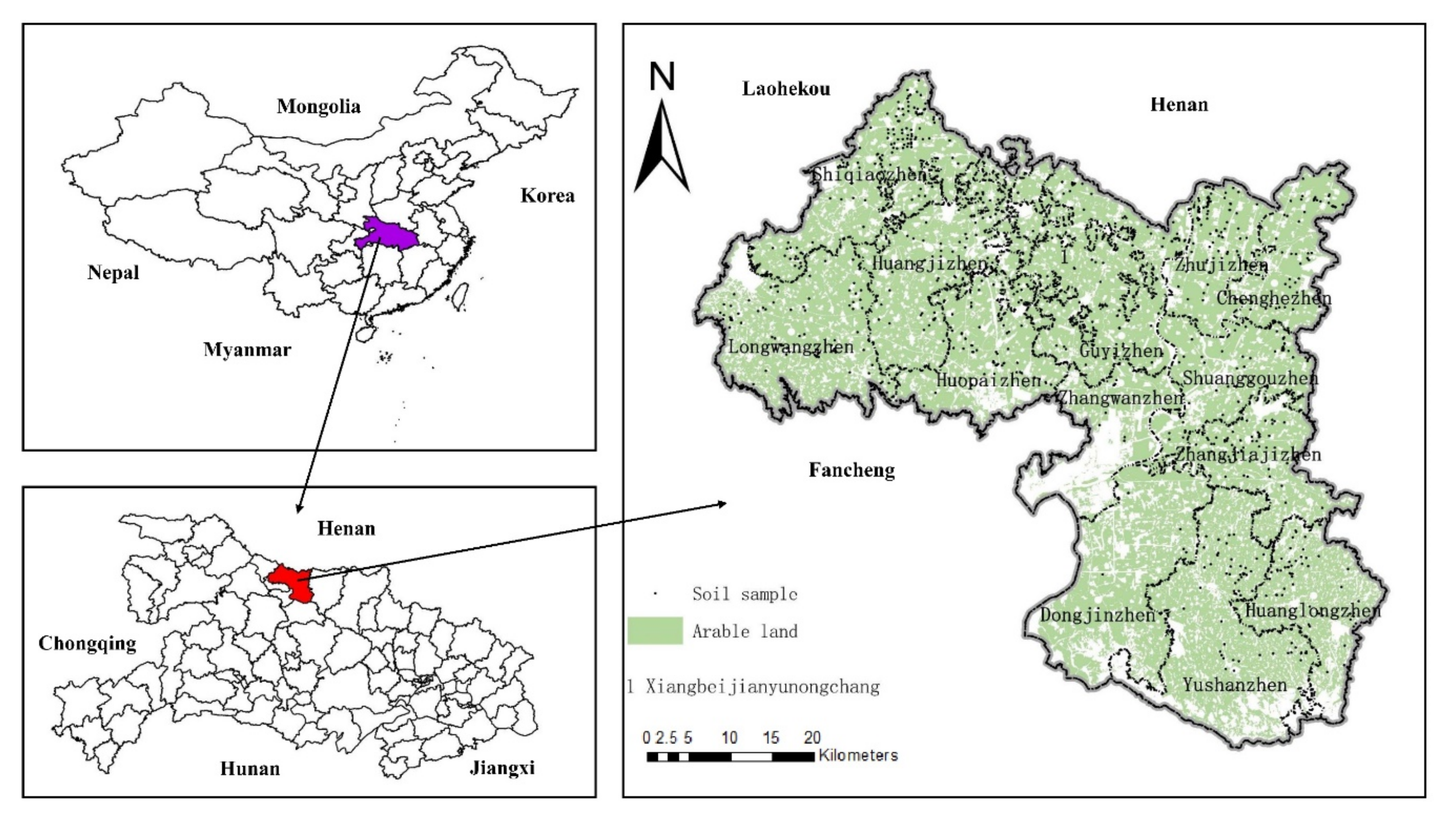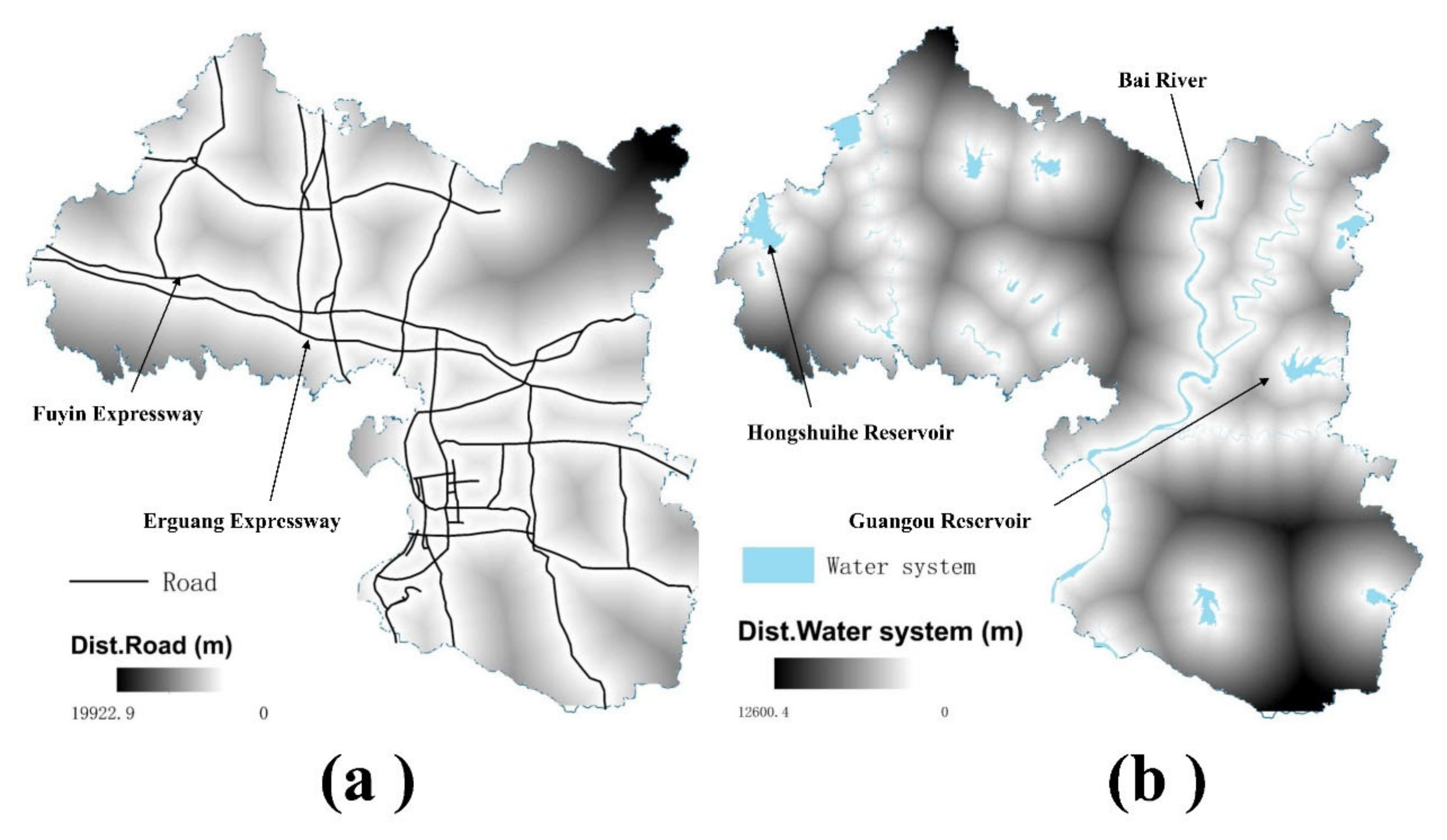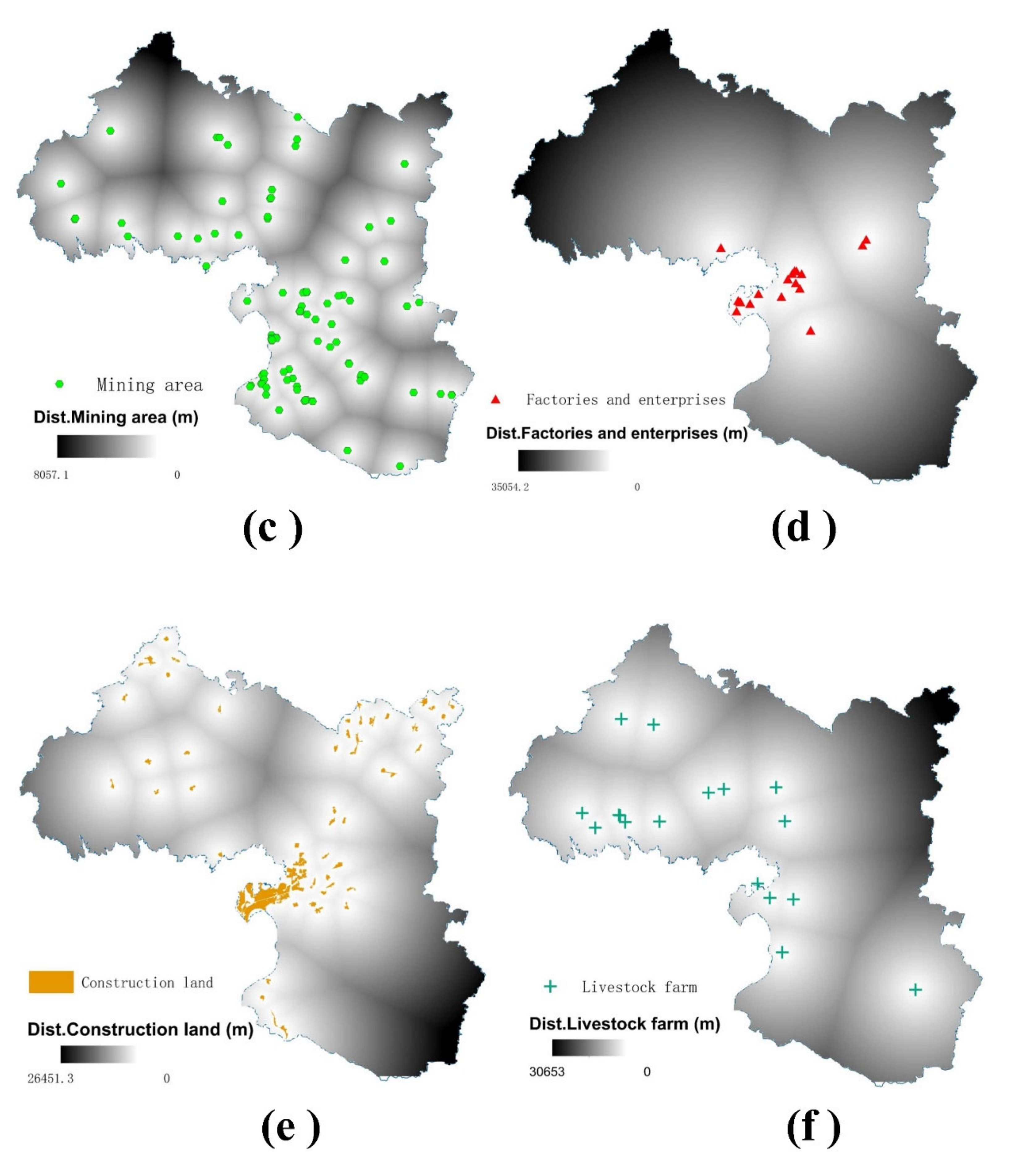Assessment of Anthropogenic Sources of Potentially Toxic Elements in Soil from Arable Land Using Multivariate Statistical Analysis and Random Forest Analysis
Abstract
:1. Introduction
2. Materials and Methods
2.1. Study Location and Field Sampling
2.2. Sample Analysis
2.3. Experimental Method
2.3.1. Analytical Framework
2.3.2. Principal Component Analysis
2.3.3. Random Forest Analysis
3. Results
3.1. Concentrations of Potentially Toxic Elements in Soil
3.2. Data Analysis
3.2.1. Principal Component Analysis
3.2.2. Anthropogenic Sources of Potentially Toxic Elements
3.2.3. Random Forest Analysis Results
4. Discussion
5. Conclusions
Author Contributions
Funding
Acknowledgments
Conflicts of Interest
References
- Romic, M.; Romic, D. Heavy metals distribution in agricultural topsoils in urban area. Environ. Geol. 2003, 43, 795–805. [Google Scholar] [CrossRef]
- Burges, A.; Epelde, L.; Garbisu, C. Impact of repeated single-metal and multimetal pollution events on soil quality. Chemosphere 2015, 120, 8–15. [Google Scholar] [CrossRef] [PubMed]
- Li, Z.; Ma, Z.; van der Kuijp, T.J.; Yuan, Z.; Huang, L. A review of soil heavy metal pollution from mines in China: Pollution and health risk assessment. Sci. Total Environ. 2014, 468, 843–853. [Google Scholar] [CrossRef] [PubMed]
- Facchinelli, A.; Sacchi, E.; Mallen, L. Multivariate statistical and GIS-based approach to identify heavy metal sources in soils. Environ. Pollut. 2001, 114, 313–324. [Google Scholar] [CrossRef]
- Jiang, Y.; Chao, S.; Liu, J.; Yang, Y.; Chen, Y.; Zhang, A.; Cao, H. Source apportionment and health risk assessment of heavy metals in soil for a township in Jiangsu Province, China. Chemosphere 2017, 168, 1658–1668. [Google Scholar] [CrossRef] [PubMed]
- Hou, D.; Al-Tabbaa, A. Sustainability: A new imperative in contaminated land remediation. Environ. Sci. Policy 2014, 39, 25–34. [Google Scholar] [CrossRef]
- Muyessar, T.; Jilili, A.; Jiang, F.Q. Distribution characteristics of soil heavy metal content in northern slope of Tianshan Mountains and its source explanation. Chin. J. EcoAgric. 2013, 21, 883–890, (In Chinese with English Abstract). [Google Scholar] [CrossRef]
- Zuzolo, D.; Cicchella, D.; Lima, A.; Guagliardi, I.; Cerino, P.; Pizzolante, A.; Thiombane, M.; de Vivo, B.; Albanese, S. Potentially toxic elements in soils of Campania region (Southern Italy): Combining raw and compositional data. J. Geochem. Explor. 2020, 213, 106524. [Google Scholar] [CrossRef]
- Zhang, X.M.; Zhang, X.Y.; Zhong, T.Y.; Jiang, H. Spatial distribution and accumulation of heavy metal in arable land soil of China. Environ. Sci. 2014, 35, 692–703. [Google Scholar]
- Li, C.F.; Cao, J.F.; Lü, J.S.; Yao, L.; Wu, Q.Y. Ecological risk assessment of soil heavy metals for different types of land use and evaluation of human health. Environ. Sci. 2018, 39, 5628–5638. [Google Scholar]
- Thiombane, M.; Zuzolo, D.; Cicchella, D.; Albanese, S.; Lima, A.; Cavaliere, M.; de Vivo, B. Soil geochemical follow-up in the Cilento World Heritage Park (Campania, Italy) through exploratory compositional data analysis and C-A fractal model. J. Geochem. Explor. 2018, 189, 85–99. [Google Scholar] [CrossRef]
- Tepanosyan, G.; Sahakyan, L.; Maghakyan, N.; Saghatelyan, A. Combination of compositional data analysis and machine learning approaches to identify sources and geochemical associations of potentially toxic elements in soil and assess the associated human health risk in a mining city. Environ. Pollut. 2020, 261, 114210. [Google Scholar] [CrossRef] [PubMed]
- Yang, Y.; Christakos, G.; Guo, M.; Xiao, L.; Huang, W. Space-time quantitative source apportionment of soil heavy metal concentration increments. Environ. Pollut. 2017, 223, 560–566. [Google Scholar] [CrossRef] [PubMed]
- Yang, Q.; Li, Z.; Lu, X.; Duan, Q.; Huang, L.; Bi, J. A review of soil heavy metal pollution from industrial and agricultural regions in China: Pollution and risk assessment. Sci. Total Environ. 2018, 642, 690–700. [Google Scholar] [CrossRef]
- Ke, X.; Gui, S.; Huang, H.; Zhang, H.; Wang, C.; Guo, W. Ecological risk assessment and source identification for heavy metals in surface sediment from the Liaohe River protected area, China. Chemosphere 2017, 175, 473–481. [Google Scholar] [CrossRef]
- Nanos, N.; Martín, J.A.R. Multiscale analysis of heavy metal contents in soils: Spatial variability in the Duero river basin (Spain). Geoderma 2012, 189, 554–562. [Google Scholar] [CrossRef]
- Hou, D.; Li, F. Complexities surrounding China’s soil action plan. Land Degrad. Dev. 2017, 28, 2315–2320. [Google Scholar] [CrossRef] [Green Version]
- Jin, Y.; O’Connor, D.; Ok, Y.S.; Tsang, D.C.; Liu, A.; Hou, D. Assessment of sources of heavy metals in soil and dust at children’s playgrounds in Beijing using GIS and multivariate statistical analysis. Environ. Int. 2019, 124, 320–328. [Google Scholar] [CrossRef]
- Wu, S.; Peng, S.; Zhang, X.; Wu, D.; Luo, W.; Zhang, T.; Zhou, S.; Yang, G.; Wan, H.; Wu, L. Levels and health risk assessments of heavy metals in urban soils in Dongguan, China. J. Geochem. Explor. 2015, 148, 71–78. [Google Scholar] [CrossRef]
- Chen, T.-B.; Zheng, Y.-M.; Lei, M.; Huang, Z.-C.; Wu, H.-T.; Chen, H.I.; Fan, K.-K.; Yu, K.; Wu, X.; Tian, Q.-Z. Assessment of heavy metal pollution in surface soils of urban parks in Beijing, China. Chemosphere 2005, 60, 542–551. [Google Scholar] [CrossRef]
- Alloway, B.J. Sources of heavy metals and metalloids in soils. In Heavy Metals in Soils; Springer: Dordrecht, The Netherlands, 2013; pp. 11–50. [Google Scholar]
- Zhao, B.; O’Connor, D.; Zhang, J.; Peng, T.; Shen, Z.; Tsang, D.C.W.; Hou, D. Effect of pyrolysis temperature, heating rate, and residence time on rapeseed stem derived biochar. J. Clean. Prod. 2018, 174, 977–987. [Google Scholar] [CrossRef]
- Josse, J.; Husson, F. Selecting the number of components in principal component analysis using cross-validation approximations. Comput. Stat. Data Anal. 2012, 56, 1869–1879. [Google Scholar] [CrossRef]
- Micó, C.; Recatalá, L.; Peris, M.; Sánchez, J. Assessing heavy metal sources in agricultural soils of an European Mediterranean area by multivariate analysis. Chemosphere 2006, 65, 863–872. [Google Scholar] [CrossRef]
- Breiman, L. Random forests. Mach. Learn. 2001, 45, 5–32. [Google Scholar] [CrossRef] [Green Version]
- CNEMC (China National Environmental Monitoring Centre). The Backgrounds of Soil Environment in China; China Environmental Science Press: Beijing, China, 1990. [Google Scholar]
- Loska, K.; Wiechula, D.; Korus, I. Metal contamination of farming soils affected by industry. Environ. Int. 2004, 30, 159–165. [Google Scholar] [CrossRef]
- Sutherland, R.A. Bed sediment-associated trace metals in an urban stream, Oahu. Hawaii Environ. Geol. 2000, 39, 611–627. [Google Scholar] [CrossRef]
- Walraven, N.; van Os, B.J.; Klaver, G.T.; Middelburg, J.J.; Davies, G.R. The lead (Pb) isotope signature, behaviour and fate of traffic-related lead pollution in roadside soils in The Netherlands. Sci. Total Environ. 2014, 472, 888. [Google Scholar] [CrossRef] [PubMed]
- Yang, Z.; Lu, W.; Long, Y.; Bao, X.; Yang, Q. Assessment of heavy metals contamination in urban topsoil from Changchun City, China. J. Geochem. Explor. 2011, 108, 27–38. [Google Scholar] [CrossRef]
- Kadi, M.W. Soil pollution hazardous to environment: A case study on the chemical composition and correlation to automobile traffic of the roadside soil of Jeddah city, Saudi Arabia. J. Hazard. Mater. 2009, 168, 1280–1283. [Google Scholar] [CrossRef]
- Yin, R.S.; Feng, X.B.; Wang, J.X. Mercury isotope variations between bioavailable mercury fractions and total mercury in mercury contaminated soil in Wanshan mercury mine, SW China. J. Chem. Geol. 2013, 336, 80–86. [Google Scholar] [CrossRef]
- Sathish, R.; Amuthan, A. Preparation, chemical analysis and sub-acute toxicity evaluation of linga pathangam (a mercury based Siddha herbo-metallic drug) in rats. Int. J. Pharm. Pharm. Sci. 2014, 6, 5. [Google Scholar]
- Mukherjee, A.B.; Zevenhoven, R.; Brodersen, J. Mercury in waste in the European Union: Sources, disposal methods and risks. Resour. Conserv. Recycl. 2004, 42, 155–182. [Google Scholar] [CrossRef] [Green Version]
- Oves, M.; Khan, M.S.; Zaidi, A.; Ahmad, E. Soil contamination, nutritive value, and human health risk assessment of heavy metals: An overview. Toxic. Heavy Met. Leg. Biorem. 2012, 1, 1–28. [Google Scholar]
- Deng, W.B.; Li, X.X.; An, Z.S.; Yang, L.; Hou, K.; Zhang, Y. Identification of sources of metal in the agricultural soils of the Guanzhong Plain, northwest China. Environ. Toxicol. Chem. 2017, 36, 1510–1516. [Google Scholar] [CrossRef] [PubMed]
- Arao, T.; Ishikawa, S.; Murakami, M.; Abe, K.; Maejima, Y.; Makino, T. Heavy metal contamination of agricultural soil and countermeasures in Japan. Paddy Water Environ. 2010, 8, 247–257. [Google Scholar] [CrossRef]








| Element | Minimum (mg/kg) | Maximum (mg/kg) | Mean (mg/kg) | SD (mg/kg) | CV (%) | Background Value |
|---|---|---|---|---|---|---|
| Cd | 0.05 | 0.36 | 0.14 | 0.03 | 0.21 | 0.17 |
| Hg | 0.02 | 1.56 | 0.05 | 0.08 | 1.54 | 0.08 |
| As | 5.76 | 21.50 | 12.62 | 2.70 | 0.21 | 12.30 |
| Pb | 19.60 | 47.50 | 29.06 | 3.91 | 0.13 | 26.70 |
| Cr | 51.60 | 103.00 | 78.41 | 9.73 | 0.12 | 86.00 |
| Element | Cd | Hg | As | Pb | Cr |
|---|---|---|---|---|---|
| Cd | 1 | ||||
| Hg | 0.276 ** | 1 | |||
| As | −0.009 | −0.089 ** | 1 | ||
| Pb | 0.288 ** | 0.114 ** | 0.678 ** | 1 | |
| Cr | 0.016 | −0.267 ** | 0.572 ** | 0.465 ** | 1 |
| Metals | Factor Load (Orthogonal Rotation) | ||
|---|---|---|---|
| PC1 | PC2 | PC3 | |
| Cd | 0.028 | 0.979 | 0.002 |
| Hg | 0.013 | 0.009 | 0.995 |
| As | 0.898 | −0.027 | −0.017 |
| Pb | 0.787 | 0.363 | 0.163 |
| Cr | 0.815 | −0.068 | −0.050 |
| % Variance contribution rate | 43.02 | 21.67 | 19.43 |
| % Cumulative contribution rate | 43.02 | 64.69 | 84.12 |
| % Increase in MSE | Cd | Hg | As | Pb | Cr |
|---|---|---|---|---|---|
| Dist. Construction land | 20.83 | 8.02 | 26.71 | 24.23 | 37.54 |
| Dist. Livestock farm | 19.04 | 14.43 | 32.88 | 31.46 | 49.38 |
| Dist. Factories and enterprises | 20.11 | 12.03 | 47.22 | 40.83 | 48.23 |
| Dist. Mining area | 23.78 | 13.64 | 43.93 | 22.61 | 45.11 |
| Dist. Water system | 20.71 | 8.10 | 28.33 | 28.74 | 39.82 |
| Dist. Road | 19.99 | 9.42 | 34.63 | 30.53 | 34.65 |
Publisher’s Note: MDPI stays neutral with regard to jurisdictional claims in published maps and institutional affiliations. |
© 2020 by the authors. Licensee MDPI, Basel, Switzerland. This article is an open access article distributed under the terms and conditions of the Creative Commons Attribution (CC BY) license (http://creativecommons.org/licenses/by/4.0/).
Share and Cite
Huang, H.; Zhou, Y.; Liu, Y.; Li, K.; Xiao, L.; Li, M.; Tian, Y.; Wu, F. Assessment of Anthropogenic Sources of Potentially Toxic Elements in Soil from Arable Land Using Multivariate Statistical Analysis and Random Forest Analysis. Sustainability 2020, 12, 8538. https://doi.org/10.3390/su12208538
Huang H, Zhou Y, Liu Y, Li K, Xiao L, Li M, Tian Y, Wu F. Assessment of Anthropogenic Sources of Potentially Toxic Elements in Soil from Arable Land Using Multivariate Statistical Analysis and Random Forest Analysis. Sustainability. 2020; 12(20):8538. https://doi.org/10.3390/su12208538
Chicago/Turabian StyleHuang, He, Yong Zhou, Yujie Liu, Ke Li, Liang Xiao, Mengyao Li, Yang Tian, and Fei Wu. 2020. "Assessment of Anthropogenic Sources of Potentially Toxic Elements in Soil from Arable Land Using Multivariate Statistical Analysis and Random Forest Analysis" Sustainability 12, no. 20: 8538. https://doi.org/10.3390/su12208538





